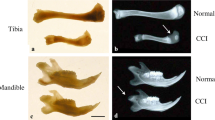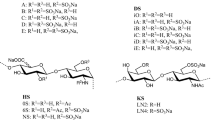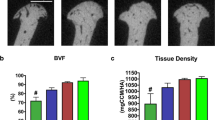Abstract
Age-related changes of the composition of the extracellular matrix of the soft tissue cover of the mandibular condyle (STC), especially of the large proteoglycans, have been investigated. Proteoglycans were extracted from the STC of neonatal, juvenile and adult domestic pigs, fractionated by density gradient centrifugation and analyzed by electrophoresis/Western blotting.
Experiments revealed firstly that a large CS/KS proteoglycan (aggrecan) is an essential constituent of the STC at all ages. This proteoglycan is required for nutrition of avascular tissues, and age-related changes in its average size and substitution with KS (keratan sulfate) may be a response to altered functional loading and tissue architecture of the STC. Secondly it was shown that a large CS/DS (chondroitin sulfate/dermatan sulfate) proteoglycan characterized by a doublet of core proteins at 200 and 250 kDa, thereby resembling perlecan, is present in the tissue of adults, but not of neonates and juveniles. Thirdly a large CS/DS proteoglycan characterized by core proteins at 350, 450 and 550 kDa, thereby resembling versican, was present in juveniles. It was detectable only weakly in neonates and not in adults. Results of core protein analysis were confirmed by results of agarose gel electrophoresis/Western blotting of the undigested proteoglycans isolated directly from the tissue extracts.
Versican is believed to destabilize cell-matrix interactions required for cell proliferation and differentiation. In this context, presence of versican-like proteoglycans in the STC of growing individuals and its disappearance in adults appears to be related to the growth potential of the mandibular condyle.
Zusammenfassung
Es wurden altersabhängige Veränderungen der Zusammensetzung der extrazellulären Matrix der Bindegewebsbedeckung des Condylus mandibulae (BCM), insbesondere bezüglich der großen Proteoglykane, untersucht. Die Proteoglykane wurden aus der BCM neonataler, juveniler und adulter Hausschweine extrahiert, durch Dichtegradientenzentrifugation fraktioniert und mittels Elektrophorese/Western Blotting analysiert.
Die Experimente zeigten zunächst, daß in jedem Alter ein großes CS/KS-reiches Proteoglykan (Aggrecan) essentieller Bestandteil der BCM ist. Dieses Proteoglykan ist für die Ernährung avaskulärer Gewebe erforderlich, und altersabhängige Veränderungen seiner durchschnittlichen Größe und Substitution mit KS (Keratansulfat) sind wahrscheinlich eine Reaktion auf geänderte funktionelle Belastungen und Gewebearchitektur der BCM. Des weiteren wurde gezeigt, daß im Gewebe Adulter, nicht aber Neonataler und Juveniler ein großes CS/DS-(Chondroitinsulfat/Dermatansulfat-)reiches Proteoglykan vorkommt, das durch eine Coreproteindoppelbande bei 200 und 250 kDa charakterisiert ist und diesbezüglich dem Proteoglycan Perlecan ähnelf. Letztlich wurde im Gewebe Juveniler ein großes CS/DS-Proteoglycan gefunden, das bezüglich seiner Coreproteine bei 350, 450 and 550 kDa dem Versican ähnelt. Dieses Proteoglykan wurde bei Neonatalen nur schwach nachgewiesen und trat bei Adulten nicht auf. Die Resultate der Coreproteinanalyse wurden durch Untersuchungen der nicht deglykosilierten, direkt aus den Gewebeextrakten isolierten Proteoglykane mittels Agarosegelelektrophorese/Western Blotting bestätigt.
Versican ist für die Destabilisierung von Zell-Matrix-Wechselwirkungen als Voraussetzung der Zellproliferation und-differenzierung von Bedeutung. In diesem Zusammenhang dürfte die Existenz eines versicanähnlichen Proteoglykans in der die Existenz eines versicanähnlichen Proteoglykans in der BCM wachsender Individuen sowie sein Fehlen im Gewebe Adulter entscheidend für das Wachstumspotential im Bereich des Condylus mandibulae sein.
Similar content being viewed by others
References
Asher RA, Scheibe RJ, Keiser HD, et al. On the existence of a cartilage like proteoglycan and link proteins in the central nervous system. Glia 1995;13:294–308.
Ben-Ami Y, von der Mark K, Franzén A, et al. Immunohistochemical studies of extracellular matrix in the condylar cartilage of the human fetal mandible: collagens and noncollagenous proteins. Am J Anat 1991;190:157–66.
Ben-Ami Y, von der Mark K, Franzén A, et al. Transformation of fetal secondory cartilage into embryonic bone in organ cultures of human mandibular condyles. Cell Tissue Res 1993;271:317–22.
Björnsson S. Size-dependent separation of proteoglycans by electrophoresis in gels of pure agarose. Anal Biochem 1993;210:292–8.
Björnsson S. Simultaneous preparation and quantitation of proteoglycans by precipitation with alcian blue. Anal Biochem 1993;210:282–91.
Breuer B, Quentin E, Cully Z, et al. A novel large dermatan sulfate proteoglycan from human fibroblasts. J Biol Chem 1991;266:13224–32.
Buckwalter JA, Roughley PJ, Rosenberg LC. Age-related changes in cartilage proteoglycans: Quantitative electron microscopic studies. Microsc Res Tech 1994;28:398–408.
Charlier JP, Petrovic A, Herrmann-Stutzmann J. Effects of mandibular hyperpropulsion on the prechondroblastic zone of young rat condyle. Am J Orthodont 1969;55:71–5.
Graber TM. Introduction. In: Graber TM, ed. Physiological principles of functional appliances. St. Louis: Mosby, 1985:1–2.
Habuchi H, Kimata K, Suzuki S. Changes in proteoglycan composition during development of rat skin. The occurrence in fetal skin of a chondroitin sulfate proteoglycan with high turnover rate. J Biol Chem 1986;261:1031–40.
Hassell JR, Schrecengost PK, Rada JA, et al. Biosynthesis of stromal matrix proteoglycans and basement membrane components by human corneal fibroblasts. Invest Ophthalmol Vis Sci 1992;33:547–57.
Heinegård D. Extraction, fractionation and characterization of proteoglycans from bovine tracheal cartilage. Biochim Biophys Acta 1972;285:181–92.
Heinegård D, Axelsson I. Distribution of keratan sulfate in cartilage proteoglycans. J Biol Chem 1977;252:1971–9.
Heinegård D, Björne-Persson A, Cöster L, et al. The core proteins of large and small interstitial proteoglycans from various connective tissues form distinct subgroups. Biochem J 1985;230:181–94.
Heinegård D, Lorenzo P, Reinholt FP, et al. Aging and the extracellular matrix. In: Buckwalter JA, Goldberg VM, Woo SLY, eds. Musculoskeletal soft-tissue aging: Impact on mobility. American Academy of Orthopaedic Surgeons, Rosemont, 1993:349–61.
Heinegård D, Paulsson M, Inerot S, et al. A novel low-molecular-weight chondroitin sulfate proteoglycan isolated from cartilage. Biochem J 1981;197:355–66.
Iozzo RV, Hassell JR. Identification of the precursor protein for the heparin sulfate proteoglycan of human colon carcinoma cells and its post-translational modifications. Arch Biochem Biophys 1989;269:239–49.
Iwata M, Carlson SS. A large chondroitin sulfate proteoglycan has the characteristics of general extracellular matrix component of adult brain. J Neurosci 1993;13:195–207.
Iwata M, Wight TN, Carlson SS. A brain extracellular matrix proteoglycan forms aggregates with hyaluronan. J Biol Chem 1993;268:15061–9.
Kantomaa T, Pirttiniemi P, Tuominen M, et al. Glycosaminoglycan synthesis in the mandibular condyle during growth adaptation. Acta Anat 1994;151:88–96.
Kantomaa T, Tuominen M, Pirttiniemi P. Effect of mechanical forces on chondrocyte maturation and differentiation in the mandibular condyle of the rat. J Dent Res 1994;73:1150–6.
Kimata K, Oike Y, Tani K, et al. A large chondroitin sulfate proteoglycan (PG-M) synthesized before chondrogenesis in the limb bud of chick embryo. J Biol Chem 1986;261:13517–25.
Komposch G. Eine tierexperimentelle Studie zur Reaktionsfähigkeit der temporomandibulären Strukturen auf kieferorthopädische Maßnahmen. Fortschr Kieferorthop 1982;43: 407–31.
Krusius T, Gehlsen KR, Ruoslahti E. A fibroblast chondroitin sulfate proteoglycan core protein contains lectin-like and growth factor-like sequences. J Biol Chem 1987;262:13120–5.
Laemmli UK. Cleavage of structural proteins during assembly of the head of bacteriophage T4. Nature 1970;227:680–5.
Lemire JM, Potter-Perigo S, Wight TN, et al. Distinct rat aortic smooth muscle cells differ in versican/PG-M expression. Arterioscler. Thromb Vasc Biol 1996;16:821–9.
Maroudas A, Schneidermann R, Popper O. The role of water, proteoglycan, and collagen in solute transport in cartilage. In: Kuettner KE, Schleyerbach R, Peyron JG, et al. eds. Articular cartilage and osteoarthritis. New York: Raven Press, 1992:355–71.
McNamara JA. Neuromuscular and skeletal adaptations to altered function in the orofacial region. Am J Orthodont 1973;64:578–606.
McNamara JA, Carlson DS. Quantitative analysis of temporomandibular joint adaptation to protrusive function. Am J Orthodont 1979;76:593–611.
McQuillan DJ, Findlay DM, Hocking AM, et al. Proteoglycans synthesized by an osteoblast-like cell line (UMR 106-01). Biochem J 1991;277:199–206.
Müller K, Roth S, Fischer DC, et al. The soft tissue cover of the mandibular condyle: Age-related changes in high buoyant density proteoglycans, free tissue water and remodelling activity. J Orofac Orthop/Fortschr Kieferorthop 1996;57:310–21.
Oike Y, Kimata K, Shinomura T, et al. Structural analysis of chick-embryo cartilage proteoglycan by selective degradation with chondroitin lyases (chondroitinases) and endo-ß-D-galactosidase (keratanse). Biochem J 1980;191:193–207.
Perides G, Rahemtulla F, Lane WS, et al. Isolation of a large aggregating proteoglycan from human brain. J Biol Chem 1992;267:23883–7.
Pirttiniemi P, Kantomaa T, Tuominen M, et al. Articular disc and eminence modeling after experimental relocation of the glenoid fossa in growing rabbits. J Dent Res 1994;73:536–43.
Proffit WR. Determinants of success with functional appliance treatment. In: Graber TM ed. Physiological principles of functional appliances. St. Louis: Mosby, 1985:63–4.
Rosenberg LC, Choi HU, Tang L-H, et al. Isolation of dermatan sulfate proteoglycans from mature bovine articular cartilages. J Biol Chem 1985;260:6304–13.
Salo L, Kantomaa T. Type II collagen expression in the mandibular condyle during growth adaptation: An experimental study in the rabbit. Calcif Tissue Int 1993;52:465–9.
Schönherr E, Järveläinen HT, Sandell LJ, et al. Effects of platelet-derived growth factor and transforming growth factor-b1 on the synthesis of a large versican-like chondroitin sulfate proteoglycan by arterial smooth muscle cells. J Biol Chem 1991;266: 17640–7.
Shinomura T, Nishida Y, Ito K, et al. cDNA cloning of PG-M, a large chondroitin sulfate proteoglycan expressed during chondrogenesis in chick limb buds. J Biol Chem 1993;268: 14461–9.
Silbermann M, von der Mark K. An immunohistochemical study of the distribution of matrical protein in the mandibular condyle of neonatal mice. I. Collagens. J Anat 1990;170:11–22.
Stöckli PW, Willert HG. Tissue reactions in the temporomandibular joint resulting from anterior displacement of the mandible in the monkey. Am J Orthodont 1971;60:142–55.
Stutzmann J, Petrovic A. A new parameter for estimating condylar growth direction. In: Graber, TM, ed. Physiological principles of functional appliances. St. Louis: Mosby, 1985:14–25.
SundarRaj N, Fite D, Ledbetter S, et al. Perlecan is a component of cartilage matrix and promotes chondrocyte attachment. J Cell Sci 1995;108:2663–72.
Thomas GJ, Bayliss MT, Harper K, et al. Glomerular mesangial cells in vitro synthesize an aggreagting proteoglycan immunologically related to versican. Biochem J 1994;302:49–56.
Tuominen M, Kantomaa T, Pirttiniemi P. Effect of altered loading on condylar growth in the rat. Acta Odontol Scand 1994;52:129–34.
Woodside DG, Metaxas A, Altuna G. The influence of functional appliance therapy on glenoid fossa remodelling. Am J Orthodont 1987;92:181–98.
Yamagata M, Saga S, Kato M, et al. Selective distributions of proteoglycans and their ligands in pericellular matrix of cultured fibroblasts. J Cell Sci 1993;106:55–6.
Yamagata M, Shinomura T, Kimata K. Tissue variation of two large chondroitin sulfate proteoglycans (PG-M/versican and PG-H/aggrecan) in chick embryos. Anat Embryol 1993;187:433–44.
Yamagata M, Suzuki S, Akiyama SK, et al. Regulation of cellsubstrate adhesion by proteoglycans immobilized on extracellular substrates. J Biol Chem 1989;264:8012–8.
Zimmermann DR, Dours-Zimmermann, MT, Schubert M, et al. Versican is expressed in the proliferating zone in the epidermis and in association with the elastic network of the dermis. J Cell Biol 1994;124:817–25.
Author information
Authors and Affiliations
Rights and permissions
About this article
Cite this article
Müller, K., Primm, T. & Dannhauer, KH. The soft tissue cover of the mandibular condyle. J Orofac Orthop/Fortschr Kieferorthop 59, 371–387 (1998). https://doi.org/10.1007/BF01299773
Received:
Accepted:
Issue Date:
DOI: https://doi.org/10.1007/BF01299773




